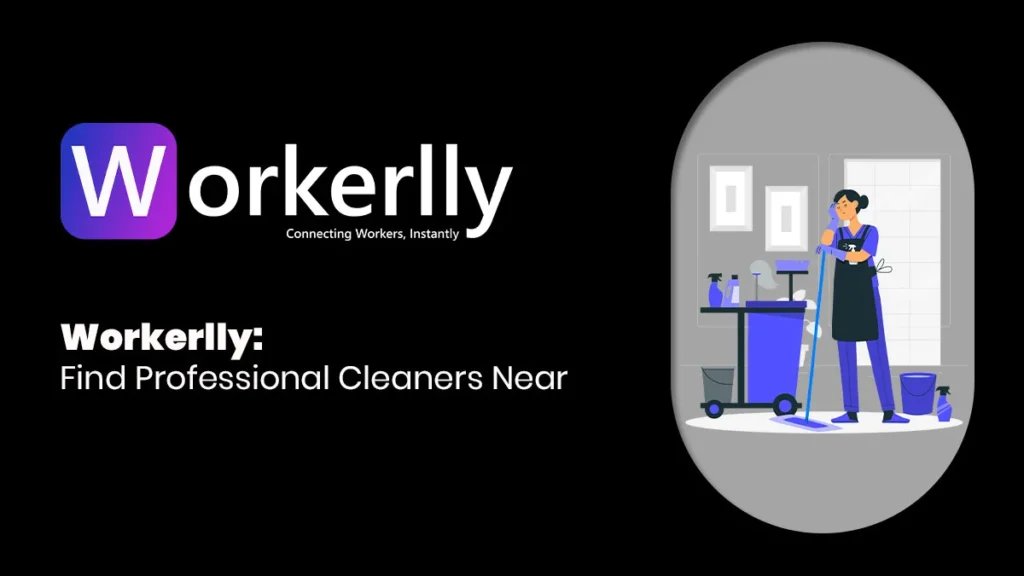
To keep your family and staff happy and healthy, it’s important to keep your house or place where you work clean. But wait! Do you know which type of cleaning you need? Cleaning is divided into two types—regular cleaning and deep cleaning.
Before choosing a cleaning process, it’s important to understand the difference between these two. At first, they can seem the same, but there are key differences between them.
A professional cleaning company provides both services, so knowing which one you need is important. In this blog, we will highlight the clear differences between deep cleaning vs. regular cleaning, helping you determine which is best for your area.
Whether you’re a homeowner wanting a cleaner living area or a business owner looking for a hygienic workplace, this article will help you make an informed choice. Continue reading to compare the value of thorough cleaning and regular cleaning.
The Benefits of Hiring a Professional House Cleaner From Workerlly
What is Regular Cleaning?
When you choose to hire a cleaning service to do routine cleaning at home or at business, experts come in once or twice a week to keep things clean.
In short, regular or standard cleaning includes normal actions that keep your space clean and hygienic, protecting the health of your residents. While some people do it themselves, corporations typically pay experts to clean huge spaces like waiting rooms, cafeterias, lobbies, kitchens, and many restrooms.
Regular cleaning is less costly than deep cleaning. To make a facility look pristine, new, and welcoming, thorough cleaning is done sporadically before an event or during a particular season as compared to on a regular schedule.
List of common tasks included in regular cleaning:
To help you understand the difference between standard and deep cleaning, here’s what regular cleaning has.
1. Cleaning Bathrooms
Cleaning bathrooms is important for keeping hygiene at home or work. Regular cleaning has:
- Mopping floors with detergents and disinfectants.
- Wiping and sanitizing sinks, toilet seats, and surfaces.
- Cleaning everyday touchpoints like faucets, doorknobs, and soap dispensers.
- Emptying trash bins and replacing liners.
- Checking and restocking needs like soap, toilet paper, and air fresheners.
2. Kitchen
The kitchen, a high-traffic area, needs regular cleaning to stop grease buildup and bacteria. Essential tasks have:
- Wiping countertops with a mild cleaner and disinfectant.
- Cleaning device exteriors, including the fridge, oven, and microwave.
- Wiping cabinets, stovetops, and dish racks.
- Sweeping, vacuuming, and mopping floors.
- Emptying trash bins and cleaning the sink.
- Dusting smaller appliances and cleaning vents and exhaust fans.
- Wiping down tables and chairs in kitchen dining areas.
3. Cleaning Floors sweeping and mopping
Clean floors are important to maintaining overall cleanliness. Regular cleaning has:
- Cleaning to remove dirt and debris.
- Vacuuming floors and hard-to-reach corners.
- Mopping with mild soap to remove stains.
- Disinfecting floors to keep them germ-free.
4. Vacuuming Carpets and Rugs
Carpets and rugs collect dirt, allergens, and stains. Routine cleaning involves:
- Vacuuming to remove dust and debris.
- Spot cleaning stains with a mild cleaner or vinegar mix.
- Remove odors by sprinkling baking soda and vacuuming after a few hours.
5. Mirrors and Windows
Regular cleaning maintains mirrors and windows spotless and usable. Key tasks are:
- Dusting frames and sills.
- Wiping glass surfaces.
- Cleaning edges and corners.
6. Surfaces
Regular cleaning helps to maintain hygiene and aesthetics. Key tasks have:
- Organizing and decluttering surfaces.
- Dusting countertops, tables, and cabinets.
- Wiping surfaces with appropriate cleaners.
- Cleaning electronics with microfiber cloths.
- Disinfecting frequently connected areas like switches and handles.
- Spot cleaning walls to remove colors and smudges.
7. Disinfecting/Sanitizing
Sanitizing is important for preventing infections and some steps are:
- Wiping high-touch things like doorknobs, light switches, and countertops.
- Utilizing EPA-approved disinfectants to kill pathogens.
- Disinfecting soft surfaces like upholstery and rugs with spray disinfectants.
What is Deep Cleaning?

Deep cleaning goes beyond day-to-day chores and focuses on always-ignored places, like small rooms, neglected areas, and rarely utilized areas like backyards or storerooms. Deep cleaning is usually more costly than regular cleaning since it takes more time, effort, and skill.
Deep cleaning is done as required, usually before important occasions, during the change of seasons, or before important holidays like Diwali, or Holi, in comparison with routine cleaning, which has an established schedule. To properly do a thorough cleaning and guarantee overall sanitation and a pristine look, a professional cleaning team is typically needed.
What’s Included in Deep Cleaning?
Some specific tasks included in a deep cleaning time like:
1. Kitchen Deep Cleaning
While regular kitchen cleaning focuses on surfaces like countertops, appliances, tables, and floors, deep cleaning concerns:
- Removing and cleaning behind, under, and around appliances.
- Cleaning the interior of appliances, like ovens, air fryers, and refrigerators, using a mild soapy solution.
- Emptying cabinets and drawers for a thorough cleanse before reorganizing items.
- Scrubbing grout lines and stubborn grease stains from countertops and backsplashes.
- Wiping down walls and ceilings to remove grease, smoke marks, and mold.
- Vacuuming and cleaning under kitchen cabinets.
- Deep-cleaning trash bins to clear food residue and odors.
2. Living Room Deep Cleaning
Regular cleaning in the living room is basic dusting and mopping, whereas deep cleaning has:
- Vacuuming and steam cleaning sofas, carpets, and rugs.
- Cleaning under and behind furniture.
- Dusting walls and ceilings to remove cobwebs, mold, and stains.
- Cleaning air vents to improve indoor air quality.
- Dismantling and cleaning air conditioners for better efficiency.
- Washing and polishing windows, including panes, rails, and sills.
- Removing and dusting home decor items such as wall hangings, mirrors, paintings, and vases before returning them to their place.
3. Bathroom Deep Cleaning
While bathrooms need regular cleaning because of frequent use, deep cleaning provides a higher level of sanitation by:
- Scrubbing tile grout and removing built-up soap scum.
- Cleaning trash bins inside and out to eliminate odors.
- Removing soap residue and limescale from fixtures.
- Washing windows, door frames, and baseboards.
- Organizing and disinfecting vanity cabinets.
- Sanitizing doorknobs, faucets, and other frequently touched surfaces.
- Cleaning and replacing shower curtains while scrubbing crevices on floors and walls.
4. Bedroom Deep Cleaning
A clean bedroom encourages a healthier and more relaxing sleeping environment. Beyond the routine tasks of sweeping floors and changing bed linens, deep cleaning involves:
- Decluttering and organizing clothing and personal items.
- Dusting all surfaces, including furniture, shelves, lamps, and decor.
- Vacuuming and mopping floors, focusing on corners and under furniture.
- Steam-cleaning carpets and mattresses.
- Cleaning upholstered furniture and spot-treating stains.
- Dusting and washing window treatments such as curtains, blinds, and shades.
- Cleaning mirrors and glass surfaces for a streak-free shine.
- Using air purifiers or fresheners to maintain a pleasant aroma and improve air quality.
5. General Spaces
Common areas like hallways, staircases, lobbies, and outdoor spaces also need deep cleaning. Tasks include:
- Cleaning underneath furniture and in hard-to-reach spaces.
- Dusting ceiling fans, air vents, and light fixtures.
- Wiping down decorations, clocks, mirrors, and paintings.
- Emptying and cleaning cabinets and storage units.
- Washing windows, door frames, and baseboards.
- Scrubbing walls to remove dirt, cobwebs, and mold.
- Vacuuming wall edges, behind furniture, and hidden crevices.
- Polishing hardwood floors and wooden furniture.
- Cleaning and maintaining outdoor areas, including sidewalks and parking spaces.
While regular cleaning helps maintain everyday cleanliness, deep cleaning is important for a healthier, fresher, and more sanitized environment. By managing hidden dirt, allergens, and bacteria, deep cleaning enhances both hygiene and comfort. Scheduling a deep cleaning session periodically ensures that your home or commercial space remains spotless, well-organized, and inviting.
How To Get Professional Cleaners on Hourly Basis for Your Home
Key Differences: Deep Cleaning vs. Regular Cleaning
Regular Cleaning
Regular home cleaning, as the name suggests, involves performing regular chores to keep the house hygienic. It may be done by a cleaning service and is less expensive than deep cleaning.
Sweeping, mopping, vacuuming, dusting surfaces, cleaning appliances, sanitizing restrooms, cleaning the kitchen, emptying garbage, dusting vents, and clearing dust are all examples of routine cleaning.
Deep Cleaning
Deep cleaning is more comprehensive and deep than routine cleaning. All standard cleaning duties are handled, with a focus on neglected and challenging-to-reach places. It improves living conditions and sanitation.
Deep cleaning provides a complete and thorough clean, but it takes more time and money.
Regular cleaning and thorough cleaning differ mainly in the scope of the duties required. General tasks like dusting furniture, sweeping, mopping floors, cleaning frequently touched surfaces, and emptying garbage cans are all part of routine cleaning.
However, deep cleaning handles more difficult and time-consuming activities that are sometimes neglected in routine cleaning, like vacuuming carpets and rugs, scouring kitchen counters, cleaning under furniture, and wiping the interior of kitchen appliances.
Cost is another important difference. Deep cleaning is more costly than routine cleaning since it needs more work and covers more area.
What is the Difference Between Skilled and Professional Worker?
Room-by-Room Comparison
- Living Room
- Regular Cleaning: Regular cleaning includes dusting furniture, sweeping, mopping floors, vacuuming carpets, and wiping TV screens, cabinetry, and surfaces.
- Deep Cleaning: Deep cleaning includes vacuuming upholstery, and cleaning corners, ceilings, window frames, sills, baseboards, lights, décor, fans, and under furniture.
- Common Spaces
- Regular Cleaning: Sweeping, mopping, and dusting furniture.
- Deep Cleaning: Vacuuming carpets, wiping railings, scrubbing floors, and trimming twigs or unwanted plants.
- Bathroom
- Regular Cleaning: Cleaning and disinfecting floors, toilet seats, sinks, faucets, and trash bins.
- Deep Cleaning: Cleaning vents, dusting doors and walls, organizing cabinets, scrubbing tile grout.
- Kitchen
- Regular Cleaning: Washing dishes, wiping countertops, cleaning appliance surfaces.
- Deep Cleaning: Dusting walls and décor, wiping cabinets, cleaning vents, scrubbing built-up grime, and cleaning inside appliances like the microwave, fridge, and coffeemaker.
How to Easily Hire a Cook on an Hourly Basis Using the Workerlly
Benefits of Regular Cleaning & Deep Cleaning
Benefits of Regular Cleaning
Cleaning on a regular basis ensures that your house or place of business is always neat and clean. Here are some key benefits:
- Maintains Cleanliness: Regular cleaning helps keep dust, dirt, and grime under control, ensuring a neat and presentable environment.
- Improves Hygiene: Routine cleaning stops bacteria and germs from often touched surfaces, reducing the risk of illness.
- Saves Time & Effort: Since regular cleaning is done frequently, it prevents the accumulation of dirt, making each cleaning session faster and easier.
- Extends the Life of Furniture & Appliances: Regular dusting and wiping maintain furniture, electronics, and kitchen appliances, preventing early wear and tear.
- Enhances Indoor Air Quality: By regularly removing dust and allergens, regular cleaning facilitates healthier air circulation.
- Boosts Productivity & Comfort: A clean and organized space improves focus, productivity, and overall comfort in homes and workplaces.
Benefits of Deep Cleaning
Deep cleaning is important for tackling hidden dirt, germs, and buildup that regular cleaning might miss. Here are the key benefits:
- Thoroughly Removes Dirt & Germs: Deep cleaning targets ignored areas, stopping bacteria, mold, and allergens for a healthier area.
- Enhances Indoor Air Quality: Deep cleaning encourages air circulation and reduces airborne pollutants by cleaning carpets, carpeting, and air vents.
- Increases Surface and Appliance Life: The beauty and durability of carpets, furniture, and kitchen appliances may be maintained by cleaning them of dust.
- Prevents Pest Infestations: Destroying food particles and debris from within cabinets under furniture, and behind devices lowers the chance of pest infestations.
- Restores a Fresh & Inviting Atmosphere: Thorough cleaning gets rid of bad smells and regenerates a room’s look and feel.
- Preparing for Special Occasions: Deep cleaning ensures that your area looks pristine and well-maintained, whether it’s before an event, a seasonal change, or moving in or out.
While regular cleaning keeps regular cleanliness, deep cleaning is important for a health, fresh, and more sanitized environment. A clean and friendly atmosphere is always ensured when routine cleaning and rare deep cleaning sessions are planned.
Which One Do You Need?
When to Choose Regular Cleaning
- To keep your house or place of business hygienic and clean, regular cleaning is best.
- Regular cleaning is the better choice if you want to control dust, waste, and bacteria on a daily or weekly basis.
- You need a reasonable cleaning solution that keeps your area clean.
- You need regular cleaning chores such as dusting, sweeping, mopping, and sanitizing communal spaces.
- You would rather have cleanings completed on a regular basis to keep your space comfortable and fresh.
When Deep Cleaning Is Necessary
A thorough cleaning is essential when a facility needs more care than just regular upkeep. If you see filth, grime, or collection in places that are hard to reach, you should choose thorough cleaning.
- You haven’t had your house or place of business fully cleaned in a while.
- You’re getting ready to move in or out, have a seasonal makeover, or celebrate an important event.
- For better air quality and hygiene, you want to get rid of bacteria, allergies, and hidden pathogens.
Workerlly’s On-Demand Cleaning Services
How Users Can Hire Trusted Cleaners for Regular or Deep Cleaning
Workerlly makes it easy to help you find and hire professional cleaners for both regular and deep cleaning services. If you want daily care or a detailed deep clean, Workerlly connects you with skilled and reliable cleaning experts.
With Workerlly you got Flexible Scheduling and Real-Time Availability.
With the Workerlly app, you can book a cleaner according to your schedule and budget. The app offers real-time availability, allowing you to schedule cleaning services based on your preferred date and time.
How Workerlly Helps Customers Find the Right Cleaning Professionals
Workerlly has a very simple and easy process of hiring trusted and experienced cleaners. The platform helps users to connect with verified professionals who provide high-quality cleaning services according to their needs.
Benefits of Hiring Through Workerlly
- Verified and Experienced Cleaners – Workerlly ensures that all professionals are background-checked and trained for high-quality service.
- Competitive Pricing – Get affordable rates for both regular and deep cleaning services without compromising on quality.
- Instant Booking and Flexible Hours – Easily book a cleaner based on your schedule with real-time availability.
Frequently Asked Questions
How often should I schedule a deep cleaning?
Generally, deep cleaning should be done every three to six months, depending on how much trash and dust has accumulated in the area you live in.
Can I combine deep cleaning and regular cleaning services?
Yes! Many people choose to schedule a deep cleaning first and then maintain cleanliness with regular cleaning services.
How much does deep cleaning cost compared to regular cleaning?
Deep cleaning is more expensive than routine cleaning because it needs more time and care to detail. However, by ensuring a completely clean atmosphere, it provides advantages over time.
What areas should I focus on during a deep cleaning?
Areas that are commonly neglected by routine cleaning, such as under furniture, appliances, grout lines, air vents, ceilings, and storage places, should be the focus of deep cleaning.
Conclusion:
Your unique demands will decide whether you should choose deep cleaning or regular cleaning. Deep cleaning provides more thorough cleaning for better comfort and hygiene, even while regular maintenance helps keep a room neat. Professional cleaners for both kinds of cleaning are readily available with Workerlly’s on-demand cleaning services. Book a cleaning service that works with your schedule by downloading the Workerlly app right now!
“Download the Workerlly App & Book Your Cleaner Today!”










